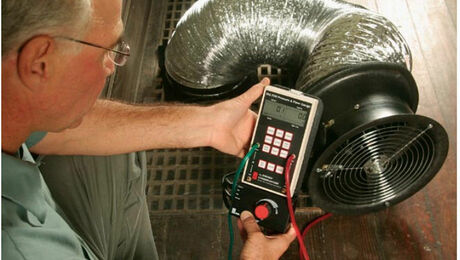Why Would My House Need a Blower-Door Test?
Few metrics are as important in high-performance building as air tightness, and a blower door is how you measure it.

More than one old-time carpenter has grumbled that buildings need to breathe, but building scientists came around long ago to believing that houses should essentially be airtight.
Uncontrolled air leakage through the building shell has at least a couple of downsides. One of the most dangerous to the building’s long-term health is the moisture that moving air takes with it. Moisture can gather inside walls and roofs and condense on cold surfaces, raising the possibility of mold and decay. Leaky buildings also use more energy and are less comfortable to live in.
Builders have a variety of materials and techniques at their disposal to limit air leaks. There’s only one way to tell just how successful they’ve been — a test with a blower door. The device is pretty simple. It consists of a curtain in a frame that blocks a door to the outside, a powerful fan, and equipment that can measure air pressure and air flow.
Here’s how it works
After most of the penetrations through the building’s exterior have been sealed (and some other precautions taken), a technician sets up the equipment in the door. The fan pushes air out of the house, depressurizing the interior. And because nature abhors a vacuum, replacement air is pulled in through all the cracks, seams, and other passages overlooked during construction. The technician adjusts the fan so the difference between inside and outside is 50 Pascals.
By measuring the volume of air expelled by the fan needed to maintain that pressure difference, the technician can calculate air leakiness. The result is expressed as airflow in cubic feet per minute at a pressure difference of 50 Pascals (CFM50). After calculating the volume of the house, the technician can convert that number to “air changes per hour at 50 pascals,” or “ACH50.”
Although ACH50 has become the benchmark for reporting results, critics complain that it can be misleading. They argue that as houses get bigger, the volume increases faster than the surface area of the house. As a result, it’s harder for smaller houses to get low blower-door results. Some specialists would rather see the metric changed to CFM50 per square foot of building envelope or shell area.
This is an ongoing debate that can quickly grow complicated
In new construction, the best time to conduct a blower-door test is after the house has been insulated but before the drywall is up. At this time, leaks will be easier to find and fix. When testing older houses, a blower door can help a contractor find and seal air leaks. That process is called “blower-door-directed air-sealing.”
The blower door dates to the early 1970s. As Martin Holladay writes at Green Building Advisor, it was developed simultaneously by two groups of researchers. The first commercially available unit was the Gadsco, which became available in 1980.
Since then, the blower door has become an extremely important tool for high-performance builders and weatherization crews. If you’re trying to get a house certified under Passive House rules, the building will have to be extremely tight. The German Passivhaus standard limits air leakage to 0.6 ACH50, a very low number when compared to standard new construction. The Passive House Institute U.S. (PHIUS) uses the CFM50-per-square-foot-of-shell-area metric in its climate-specific PHIUS + 2015 Passive Building Standard.
Either way, builders who want to hit (or exceed) these marks really have to be on their toes.
Learn how to use a blower-door test to improve a home’s energy efficiency:
- Video: Blower-Door Testing Basics
- Blower-Door Testing Basics
- Diagnostic Tools for Energy-Minded Remodelers
- Video: How to Set Up and Use a Blower Door
Fine Homebuilding Recommended Products
Fine Homebuilding receives a commission for items purchased through links on this site, including Amazon Associates and other affiliate advertising programs.

8067 All-Weather Flashing Tape

Affordable IR Camera

Reliable Crimp Connectors




























View Comments
amazing